 W
WMaritime history is the study of human interaction with and activity at sea. It covers a broad thematic element of history that often uses a global approach, although national and regional histories remain predominant. As an academic subject, it often crosses the boundaries of standard disciplines, focusing on understanding humankind's various relationships to the oceans, seas, and major waterways of the globe. Nautical history records and interprets past events involving ships, shipping, navigation, and seafarers.
 W
WThe Age of Sail was a period roughly corresponding to the early modern period in which international trade and naval warfare were dominated by sailing ships and gunpowder warfare, lasting from the mid-16th to the mid-19th centuries.
 W
WAll the Fish in the Sea: Maximum Sustainable Yield and the Failure of Fisheries Management is a 2011 book by Carmel Finley. The book argues that the policies for international fishing and whaling management were essentially locked in place by 1958, and that the United States played a large role in setting them. In the development of the international law covering fisheries, the US supported laws that would protect the US tuna and salmon fisheries while limiting the ability of other nations, and Japan in particular, to fish in US waters. The book thus ties fisheries management inseparably with Cold War politics.
 W
WBringing Whales Ashore: Oceans and the Environment of Early Modern Japan is a 2018 book by Jakobina K. Arch. The book details the history of whaling in Japan, especially during the Tokugawa period. In particular, the book notes the relationship between the Japanese archipelago and the maritime space around it, as well as between the shore and inland populations of Japan. While shore-based and near-shore whaling was big business in early modern Japan, employing tens of thousands of workers and drawing substantial investment, the practice was unsustainable, and it fell off before the middle of the nineteenth century, even before American whaling ships had a major impact on Pacific whale species. If the oceans are paid attention to as global environments and as key sources of nutrients and economic resources, the book argues, then Tokugawa Japan was neither as self-sufficient nor as sustainable as has previously been argued.
 W
WThe clipper route was the traditional route derived from the Brouwer Route and sailed by clipper ships between Europe and the Far East, Australia and New Zealand. The route ran from west to east through the Southern Ocean, in order to make use of the strong westerly winds of the Roaring Forties. Many ships and sailors were lost in the heavy conditions along the route, particularly at Cape Horn, which the clippers had to round on their return to Europe.
 W
WThe Maritime history of Europe represents the era of recorded human interaction with the sea in the northwestern region of Eurasia in areas that include shipping and shipbuilding, shipwrecks, naval battles, and military installations and lighthouses constructed to protect or aid navigation and the development of Europe. Europe is situated between several navigable seas and intersected by navigable rivers running into them in a way which greatly facilitated the influence of maritime traffic and commerce. Great battles have been fought in the seas off of Europe that changed the course of history forever, including the Battle of Salamis in the Mediterranean, the Battle of Gravelines at the eastern end of the English Channel in the summer of 1588, in which the “Invincible” Spanish Armada was defeated, the Battle of Jutland in World War I, and World War II’s U-boat war.
 W
WThe era of European and American voyages of scientific exploration followed the Age of Discovery and were inspired by a new confidence in science and reason that arose in the Age of Enlightenment. Maritime expeditions in the Age of Discovery were a means of expanding colonial empires, establishing new trade routes and extending diplomatic and trade relations to new territories, but with the Enlightenment scientific curiosity became a new motive for exploration to add to the commercial and political ambitions of the past. See also List of Arctic expeditions and List of Antarctic expeditions.
 W
WThe maritime European exploration of Australia consisted of several waves of white European seafarers who sailed the edges of the Australian continent. Dutch navigators were the first Europeans known to have explored and mapped the Australian coastline. The first documented encounter was that of Dutch navigator Willem Janszoon, in 1606. Dutch seafarers also visited the west and north coasts of the continent, as did French explorers.
 W
WThe exploration of North America by non-indigenous people was a continuing effort to map and explore the continent and advance the economic interests of said non-indigenous peoples of North America. It spanned centuries, and consisted of efforts by numerous people and expeditions from various foreign countries to map the continent. See also the European colonization of the Americas
 W
WIn the middle third of the 19th Century, the clippers which carried cargoes of tea from China to Britain would compete in informal races to be first ship to dock in London with the new crop of each season. The Great Tea Race of 1866 was keenly followed in the press, with an extremely close finish. Taeping docked 28 minutes before Ariel - after a passage of more than 14,000 miles. Ariel had been ahead when the ships were taken in tow by steam tugs off Deal, but after waiting for the tide at Gravesend the deciding factor was the height of tide at which one could enter the different docks used by each ship. The third finisher, Serica, docked an hour and 15 minutes after Ariel. These three ships had left China on the same tide and arrived at London 99 days later to dock on the same tide. The next to arrive, 28 hours later, was Fiery Cross, followed, the next day, by Taitsing.
 W
WThe Hattendorf Prize for Distinguished Original Research in Maritime History is awarded by the United States Naval War College for distinguished academic achievement in publishing original research that contributes to a deeper historical understanding of the broad context and interrelationships involved in the roles, contributions, limitations, and uses of the sea services in history. The prize is awarded approximately every two years and consists of a $10,000 cash prize, a specially designed bronze medal, and a citation. The Prize Laureate is expected to deliver a lecture at the United States Naval War College on the occasion of the award.
 W
WHistorical ports may be found where ancient civilizations have developed maritime trade.
 W
WThe Hulett was an ore unloader that was widely used on the Great Lakes of North America. It was unsuited to tidewater ports because it could not adjust for rising and falling tides, although one was used in New York City.
 W
WHydrarchy, is the organizational structure of a ship, or the ability for individual(s) to gain power over land by ruling through the instrument of water, as defined by English poet Richard Braithwaite (1588-1673), who coined the term.
 W
WThroughout naval history during times of war battles, blockades, and other patrol missions would often result in the capture of enemy ships or those of a neutral country. If a ship proved to be a valuable prize efforts would sometimes be made to capture the vessel while inflicting the least amount of damage as was practically possible. Both military and merchant ships were captured, often renamed, and then used in the service of the capturing country's navy, or in many cases sold to private individuals who would break them up for salvage, or use them as merchant vessels, whaling ships, slave ships, or the like. As an incentive to search far and wide for enemy ships, the proceeds of the sale of the vessels and their cargoes were divided up as prize money among the officers and crew of capturing crew members with the distribution governed by regulations the captor vessel's government had established. Throughout the 1800s war prize laws were established to help opposing countries settle claims amicably. Private ships were also authorized by various countries at war through a Letter of marque, legally allowing a ship and commander to engage and capture vessels belonging to enemy countries. In these cases contracts between the owners of the vessels on the one hand, and the captains and the crews on the other, established the distribution of the proceeds from captures.
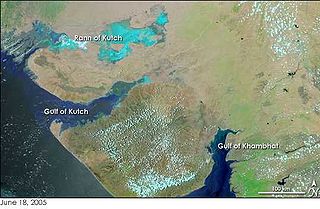 W
WIndian maritime history begins during the 3rd millennium BCE when inhabitants of the Indus Valley initiated maritime trading contact with Mesopotamia. As per the Vedic records. the Indian traders and merchants traded with Far East and the Arabia. During the Maurya period, there was a definite 'naval department' to supervise the ships and trade. The Indian products reached the Romans during the rule of Augustus and Indian merchants earned about 1 million sistreces annually, which was later, not appreciated by the Romans themselves. The Roman historian Strabo mentions an increase in Roman trade with India following the Roman annexation of Egypt. Strabo reports that during the time when Aelius Gallus was Prefect of Egypt, he saw 120 ships ready to leave for India at the Red Sea port of Myos Hormos. As trade between India and the Greco-Roman world increased spices became the main import from India to the Western world, bypassing silk and other commodities. Indians were present in Alexandria while Christian and Jewish settlers from Rome continued to live in India long after the fall of the Roman Empire, which resulted in Rome's loss of the Red Sea ports, previously used to secure trade with India by the Greco-Roman world since the Ptolemaic dynasty. The Indian commercial connection with South East Asia proved vital to the merchants of Arabia and Persia during the 7th–8th century. A study published in 2013 found that some 11 percent of Australian Aboriginal DNA is of Indian origin and suggests these immigrants arrived about 4,000 years ago, possibly at the same time dingoes first arrived in Australia.
 W
WLaw of the sea is a body of international law governing the rights and duties of states in maritime environments. It concerns matters such as navigational rights, sea mineral claims, and coastal waters jurisdiction.
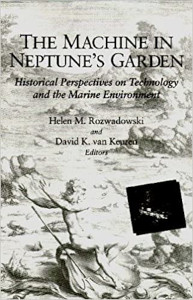 W
WThe Machine in Neptune's Garden: Historical Perspectives on Technology and the Marine Environment is a 2004 book edited by Helen M. Rozwadowski and David K. van Keuren. The book takes its name from Leo Marx's influential book The Machine in the Garden. It is a product of the Maury III conference on the history of oceanography held in Monterey, California in 2001. It argues the centrality of technology to the acquisition of knowledge of the oceans and contains ten thematically linked essays on the indispensable role of technology in the history of ocean science. It "demonstrate[s] that historians of science and technology should pay more attention to the history and historiography of oceanography." It is the most prominent work combining the history of technology, environmental history, and history of ocean sciences, and it is considered a foundational work in history of technology of the oceans and in the history of the marine environment.
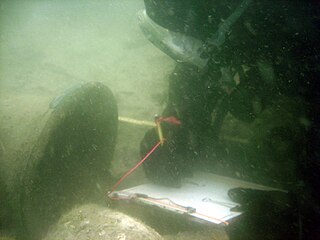 W
WMaritime archaeology is a discipline within archaeology as a whole that specifically studies human interaction with the sea, lakes and rivers through the study of associated physical remains, be they vessels, shore-side facilities, port-related structures, cargoes, human remains and submerged landscapes. A specialty within maritime archaeology is nautical archaeology, which studies ship construction and use.
 W
WThe maritime republics of the Mediterranean Basin were thalassocratic city-states in Italy and Dalmatia during the Middle Ages. The best known among them were Venice, Genoa, Pisa and Amalfi; less known, but not always less important, are Ragusa, Gaeta, Ancona, and the little Republic of Noli.
 W
WThe naval stores industry collects, processes, and markets forest products refined from the oleoresin of the slash pine and longleaf pine trees. The industry was associated with the maintenance of the wooden ships and sailing tackle of pre-20th century navies, which were caulked and waterproofed using the pitch of the pine tree.
 W
WThe history of navigation is the history of seafaring, the art of directing vessels upon the open sea through the establishment of its position and course by means of traditional practice, geometry, astronomy, or special instruments. A few people have excelled as seafarers, prominent among them the Austronesians, the Harappans, the Phoenicians, the Iranians, the ancient Greeks, the Romans, the Arabs, the ancient Indians, the Norse, the Chinese, the Venetians, the Genoese, the Hanseatic Germans, the Portuguese, the Spanish, the English, the French, the Dutch and the Danes.
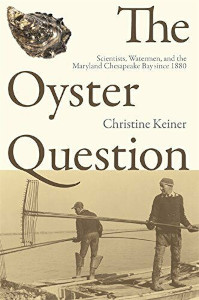 W
WThe Oyster Question: Scientists, Watermen, and the Maryland Chesapeake Bay since 1880 is a 2009 book by Christine Keiner. It examines the conflict between oystermen and scientists in the Chesapeake Bay from the end of the nineteenth century to the present, which includes the period of the so-called "Oyster Wars" and the precipitous decline of the oyster industry at the end of the twentieth century. The book engages the myth of the "Tragedy of the Commons" by examining the often fraught relationship between local politics and conservation science, arguing that for most of the period Maryland's state political system gave rural oystermen more political clout than politicians and the scientists they appointed and allowing oystermen to effectively manage the oyster bed commons. Only towards the end of the twentieth century did reapportionment bring suburban and urban interests more political power, by which time they had latched on to oystermen as elements of the area's heritage and incorporated them and the oysters into broader conservation efforts. An important theme is the "intersection[] of scientific knowledge with experiential knowledge in the context of use," in that Keiner "treats the knowledge of the Chesapeake Bay’s oystermen alongside that of biologists." "Through her analysis, Keiner effectively reframes how environmental historians have analyzed histories of common resources and provides a working model for integrating historical and ecological information to bridge the histories of science and environmental history."
 W
WGenerally, packet trade is any regularly scheduled cargo, passenger and mail trade conducted by ship. The ships are called "packet boats" as their original function was to carry mail.
 W
WThe Portuguese Indian Armadas were the fleets of ships, organized by the crown of the Kingdom of Portugal and dispatched on an annual basis from Portugal to India, principally to Portuguese Goa and other colonies such as Damaon. These armadas undertook the Carreira da Índia, following the sea route around the Cape of Good Hope first opened up by Vasco da Gama in 1497–1499.
 W
WA Sailortown is a district in seaports that catered to transient seafarers. These districts frequently contained boarding houses, public houses, brothels, tattoo parlours, print shops, shops selling nautical equipment, and religious institutions offering aid to seamen; usually there was also a police station, a magistrate's court and a shipping office. Because it took several days, in the past, to unload ships, crews would spend this time in sailortown. These were "generic locations—international everyplaces existing in nearly every port." Cecily Fox Smith wrote that 'dockland, strictly speaking, is of no country—or rather it is of all countries'". Sailortowns were places where local people, immigrants, social and religious reformers, and transitory sailors met.
 W
WA Science on the Scales: The Rise of Canadian Atlantic Fisheries Biology, 1898-1939 is a 2011 book by Jennifer Hubbard. The book provides an analysis of Canadian fisheries history with the tools of the professional historian, when most earlier works on the topic came from fisheries scientists themselves.
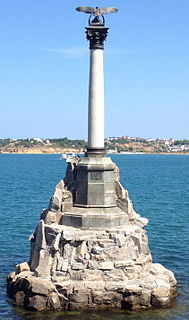 W
WScuttling is the deliberate sinking of a ship by allowing water to flow into the hull. This can be achieved in several ways—seacocks or hatches can be opened to the sea, or holes may be ripped into the hull with brute force or with explosives. Scuttling may be performed to dispose of an abandoned, old, or captured vessel; to prevent the vessel from becoming a navigation hazard; as an act of self-destruction to prevent the ship from being captured by an enemy force ; as a blockship to restrict navigation through a channel or within a harbor; to provide an artificial reef for divers and marine life; or to alter the flow of rivers.
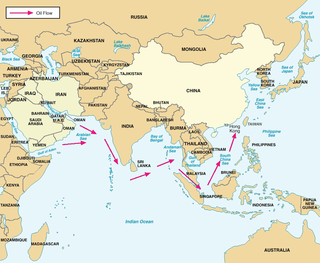 W
WSea lines of communication is a term describing the primary maritime routes between ports, used for trade, logistics and naval forces. It is generally used in reference to naval operations to ensure that SLOCs are open, or in times of war, to close them.
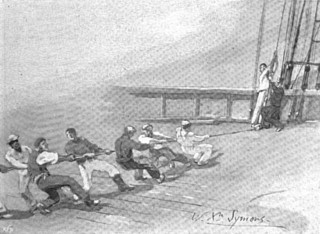 W
WA sea shanty, chantey, or chanty is a genre of traditional folk song that was once commonly sung as a work song to accompany rhythmical labor aboard large merchant sailing vessels. They were found mostly on British and other European ships, and some had roots in lore and legend. The term shanty most accurately refers to a specific style of work song belonging to this historical repertoire. However, in recent, popular usage, the scope of its definition is sometimes expanded to admit a wider range of repertoire and characteristics, or to refer to a "maritime work song" in general.
 W
WA seaman's chest is a wooden chest which was commonly used by sailors to store personal belongings. They are also known as sea chests, not to be confused with the recesses found in the hull of certain ships.
 W
WA ship chandler is a retail dealer who specializes in providing supplies or equipment for ships.
 W
WThe ship's cat has been a common feature on many trading, exploration, and naval ships dating to ancient times. Cats have been carried on ships for many reasons, most importantly to control rodents. Vermin aboard a ship can cause damage to ropes, woodwork, and more recently, electrical wiring. In addition, rodents threaten ships' stores, devour crews' foodstuff, and can cause economic damage to ships' cargo, such as grain. They are also a source of disease, which is dangerous for ships that are at sea for long periods of time. Rat fleas are carriers of plague, and rats on ships were believed to be a primary vector of the Black Death.
 W
WThe swallow tattoo was a symbol used historically by sailors to show off their sailing experience. Of British origin in the early days of sailing, it was the image of a barn swallow, usually tattooed on the chest, hands or neck.
 W
WThis article discusses the history of whaling from prehistoric times up to the commencement of the International Whaling Commission (IWC) moratorium on commercial whaling in 1986. Whaling has been an important subsistence and economic activity in multiple regions throughout human history. Commercial whaling dramatically reduced in importance during the 19th century due to the development of alternatives to whale oil for lighting, and the collapse in whale populations. Nevertheless, some nations continue to hunt whales even today.
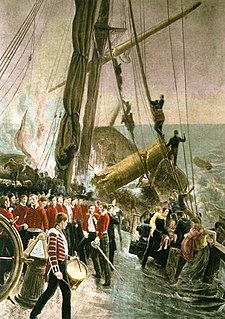 W
W"Women and children first" is a code of conduct dating from 1852, whereby the lives of women and children were to be saved first in a life-threatening situation, typically abandoning ship, when survival resources such as lifeboats were limited. However, it has no basis in maritime law.